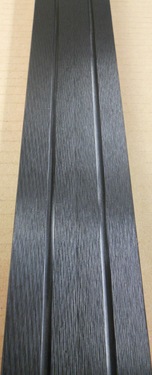Structure Types

Each different snow combination between dry, wet, soft, hard, cold, warm, new and old, uses a different structure. A lot of times, the structure has a certain range and can be used in multiple conditions, but if the wrong structure is used, it can be minutes added to a finish time.
The structure has four main components: depth, frequency, pattern, and texture. Based on the conditions, each one is varied to create the perfect mix so that there is enough for water to move out from underneath the base but not too much so that it creates a suction effect, slowing the ski.
Depth ranges from an aggressive grind which is usually up to 0.06 mm to a light grind, which is as little as 0.01 mm.
Frequency is how often the lines are cut into the base of the ski.
Pattern is what can be seen from looking at the base of the ski. An example of a ground ski is the picture on the left.
Texture are based on the grinding process of the pressure used as well as the speed the machine is run on. It can also depend on how many times the ski is cut, which makes a layering effect.
The structure has four main components: depth, frequency, pattern, and texture. Based on the conditions, each one is varied to create the perfect mix so that there is enough for water to move out from underneath the base but not too much so that it creates a suction effect, slowing the ski.
Depth ranges from an aggressive grind which is usually up to 0.06 mm to a light grind, which is as little as 0.01 mm.
Frequency is how often the lines are cut into the base of the ski.
Pattern is what can be seen from looking at the base of the ski. An example of a ground ski is the picture on the left.
Texture are based on the grinding process of the pressure used as well as the speed the machine is run on. It can also depend on how many times the ski is cut, which makes a layering effect.